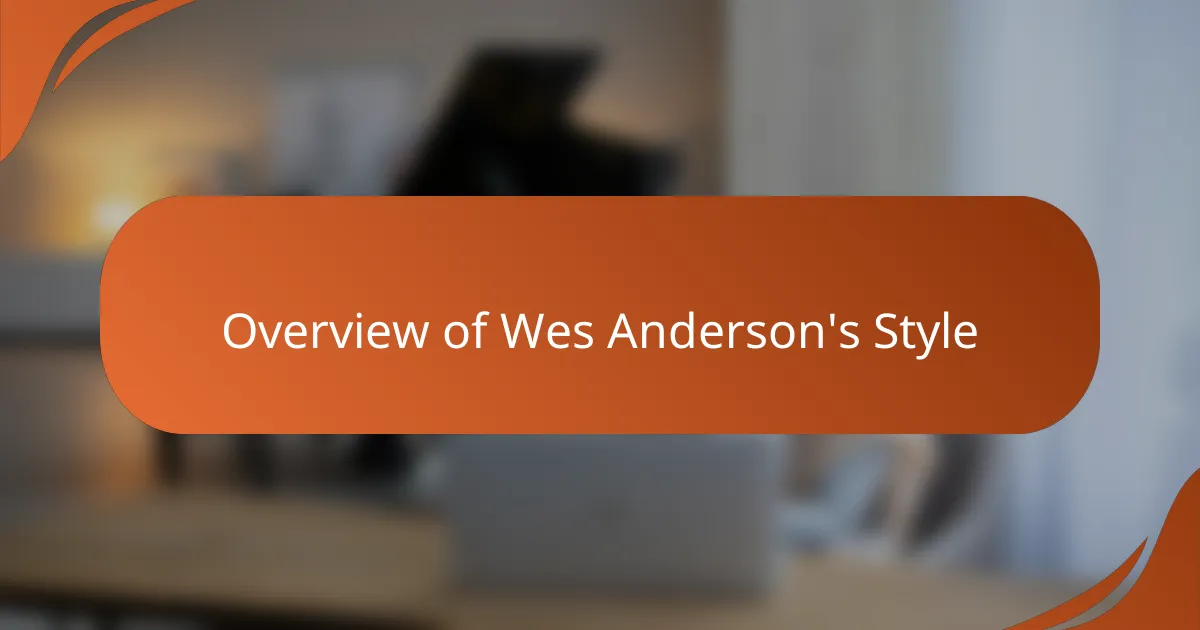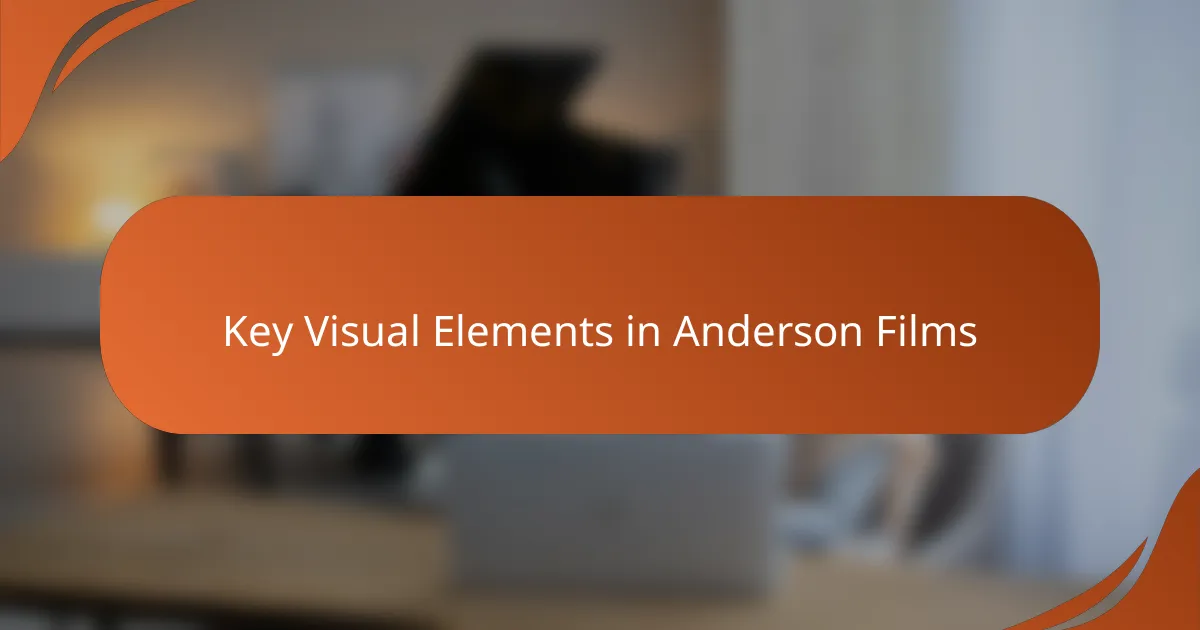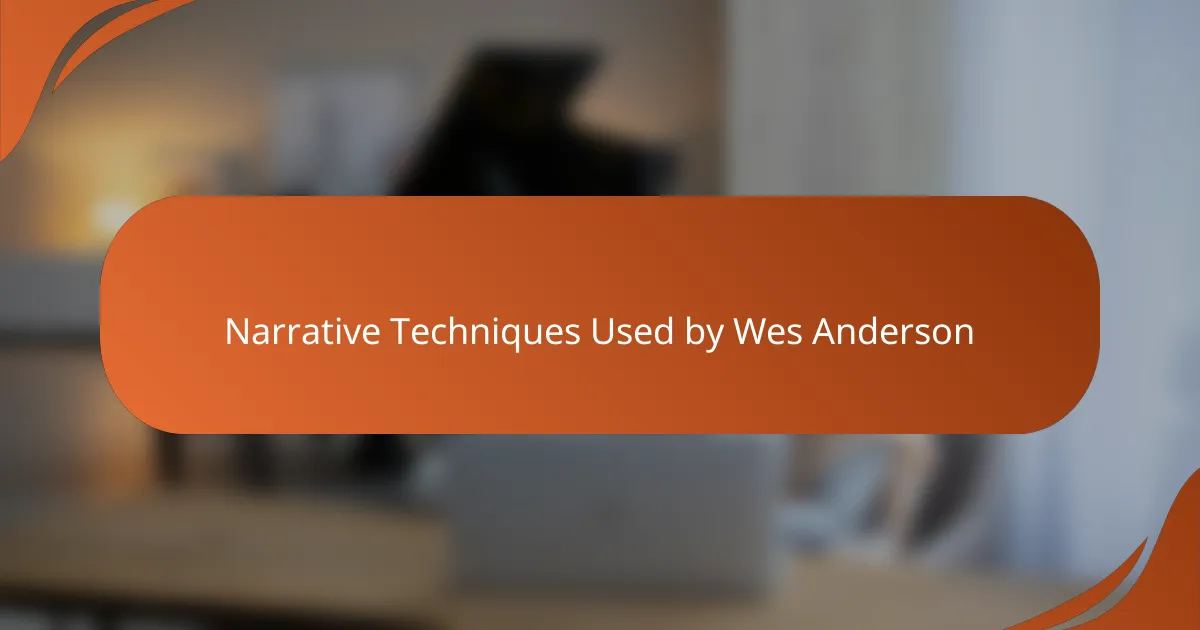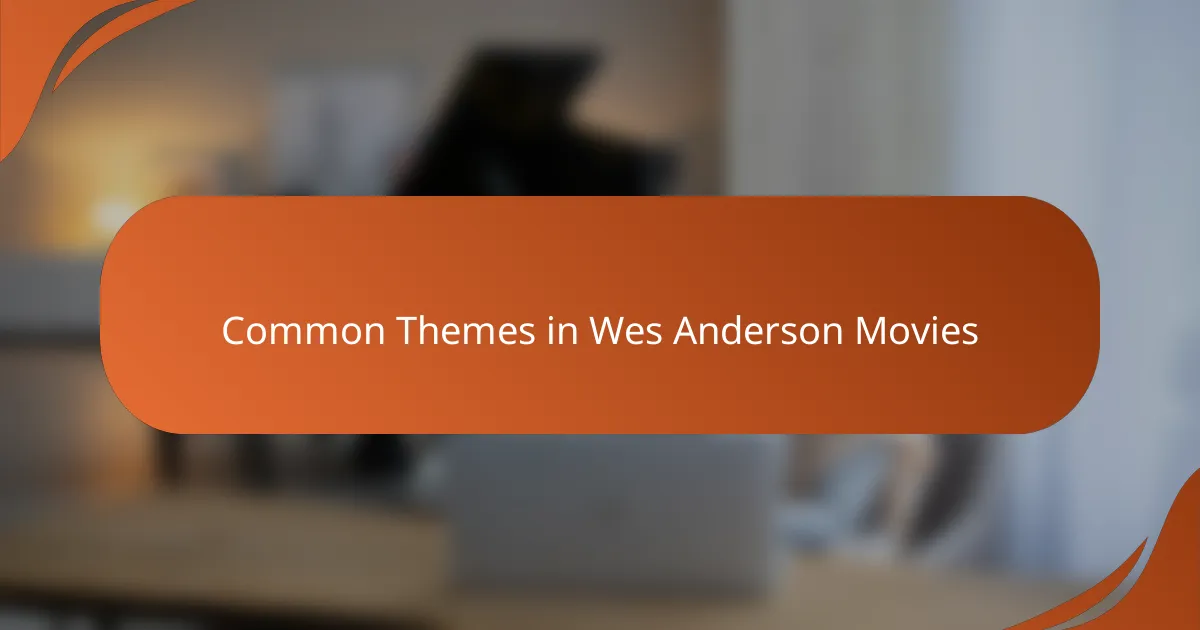Key takeaways
- Film aesthetics, including color palettes and camera angles, significantly enhance storytelling and emotional connection in cinema reviews.
- Wes Anderson’s unique style features precise symmetry, vibrant color schemes, and intricate set designs that evoke nostalgia and emotional depth.
- His narrative techniques, like chapter-like sequences and deadpan narration, create a distinctive, intimate storytelling experience that lingers with viewers.
- Common themes in Anderson’s films include dysfunctional families and outsider characters, often infused with a blend of humor and melancholy.

Understanding Film Aesthetics in Cinema Reviews
When I dive into a film review, I always find myself paying close attention to the film’s aesthetic choices. It’s not just about the plot or performances, but how visual and stylistic elements come together to create a mood. Have you ever noticed how a single frame can evoke emotions before a word is even spoken?
Film aesthetics are like the language of cinema that speaks directly to our senses. Over the years, I’ve come to appreciate how color palettes, camera angles, and set designs shape the storytelling experience. They tell us more about characters and themes than dialogue ever could, making the review richer and more insightful.
Understanding these choices helps me connect deeply with the film and articulate that connection in my reviews. It raises a question for me every time: what is the filmmaker trying to say beyond the story? Exploring this often reveals layers that casual viewers might miss, turning a simple film review into a discovery process.

Overview of Wes Anderson’s Style
Wes Anderson’s style immediately grabs my attention with its precise symmetry and vibrant color schemes. It’s like stepping into a carefully crafted dollhouse, where every detail feels intentional and charged with meaning. Have you ever noticed how his use of pastel hues and meticulous framing almost makes you want to pause the screen and admire the scene as art?
What fascinates me most is his blend of whimsy and melancholy—there’s a nostalgic warmth wrapped in the quirky, almost storybook-like visuals. Watching his films, I often feel like I’m revisiting a cherished memory that’s both comforting and a little bittersweet. It’s this emotional layering, conveyed through distinct visual storytelling, that sets his work apart in my mind.
Anderson’s signature style also includes his trademark tracking shots and slow, deliberate camera movements. These techniques aren’t just aesthetic choices; they invite the viewer to linger, to absorb the peculiar world he’s created. I find myself drawn into these moments, caught between admiring the craftsmanship and wondering what deeper truths lie beneath the surface.

Key Visual Elements in Anderson Films
What strikes me first about Wes Anderson’s visuals is his obsession with symmetry. It’s almost hypnotic how every shot feels perfectly balanced, like a painting hung just right on a gallery wall. Have you ever paused a scene just to admire that flawless alignment? I find it creates a sense of order that both grounds the quirky stories and enhances their charm.
Color plays a huge role too. Those pastel palettes and saturated hues aren’t just pretty—they’re carefully chosen to evoke feelings from nostalgia to whimsy. When I watch his films, I’m often transported back to childhood memories or daydreams, simply because of how the colors wrap around the scenes like a warm blanket.
Another thing I love is the way Anderson uses precise set designs filled with tiny, deliberate details. It’s like walking into a world where everything has a purpose and a story if you look closely enough. This attention to detail invites me to explore the frame beyond the main action, turning each scene into a treasure hunt of visual clues.

Narrative Techniques Used by Wes Anderson
Wes Anderson’s narrative techniques often feel like stepping into a carefully constructed storybook. I’ve noticed how he uses chapter-like sequences that segment his films, almost inviting me to read a whimsical bedtime tale rather than watch a typical movie. Doesn’t this approach make the storytelling feel both intimate and stylized, like you’re part of an illustrated novel?
One thing that always resonates with me is his use of deadpan narration combined with quirky character interactions. It’s as if the dialogue is purposely restrained to highlight the emotional undercurrents beneath the surface. When I watch, I find myself leaning in, trying to catch the subtle humor and pathos hidden between the lines—it’s a storytelling style that feels refreshingly clever yet heartfelt.
I also appreciate how Anderson’s narrative rhythm is deliberate and unhurried, almost like he’s giving you time to savor every moment. Have you ever felt that rare pleasure of fully absorbing a scene without the usual cinematic rush? That pacing creates a unique atmosphere where stories unfold with a gentle, poetic grace, making every emotion linger just a little longer.

Common Themes in Wes Anderson Movies
One theme I keep spotting in Wes Anderson’s films is the focus on dysfunctional families and complex relationships. It’s fascinating how he portrays these connections with a mix of humor and tenderness, making the characters feel deeply flawed yet incredibly relatable. Have you ever watched a scene where the awkwardness between family members somehow felt both painful and oddly comforting? That’s Anderson’s magic at work.
Another common thread is the celebration of outsider characters—those misfits or eccentrics who don’t quite fit into the conventional world. I find myself rooting for these oddballs because Anderson paints them with such empathy and charm. It’s like he’s reminding us that everyone’s quirks and imperfections deserve a warm spotlight.
Melancholy often lingers beneath the whimsy in his stories, giving them emotional depth beyond the quirky visuals. There’s this bittersweet quality that makes me reflect on loss, longing, or the passage of time. Isn’t it intriguing how a brightly colored set or a playful soundtrack can carry such emotional weight? Anderson’s themes always nudge me to feel something more profound beneath the surface.

How to Spot Wes Anderson’s Aesthetic in Reviews
When I read reviews that capture Wes Anderson’s aesthetic, I immediately look for mentions of his trademark symmetry and deliberate color choices. Do the reviewers describe scenes as meticulously balanced or “like a painting”? That’s often my first sign that Anderson’s visual language is being recognized and appreciated.
I also pay attention to how the review highlights the emotional resonance beneath the quirky style. Is there talk of whimsy mixed with melancholy, or a nostalgic warmth enveloping the narrative? When a critic senses those layers, it tells me they’re truly engaging with Anderson’s unique blend of visual and emotional storytelling.
Finally, I notice if reviewers comment on the pacing and framing techniques—like slow tracking shots or chapter-like segmentation—that invite viewers to linger in Anderson’s carefully crafted worlds. Have you ever caught yourself re-reading a review because it perfectly captures that feeling of stepping into a storybook? That, to me, signals a deep understanding of his cinematic voice.